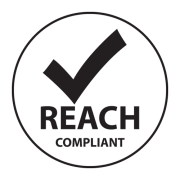
The Directive on the restriction of the use of certain hazardous substances in electrical and electronic equipment 2002/95/EC commonly referred to as the Restriction of Hazardous Substances Directive or RoHS was adopted in February 2003 by the European Union. The RoHS directive took effect on 1 July 2006, and is required to be enforced and become law in each member state. This directive restricts the use of six hazardous materials in the manufacture of various types of electronic and electrical equipment. It is closely linked with the Waste Electrical and Electronic Equipment Directive (WEEE) 2002/96/EC which sets collection, recycling and recovery targets for electrical goods and is part of a legislative initiative to solve the problem of huge amounts of toxic e-waste.
RoHS is often referred to as the lead-free directive, but it restricts the use of the following ten substances:
- Lead (Pb): < 1000 ppm
- Mercury (Hg): < 100 ppm
- Cadmium (Cd): < 100 ppm
- Hexavalent Chromium: (Cr VI) < 1000 ppm
- Polybrominated Biphenyls (PBB): < 1000 ppm
- Polybrominated Diphenyl Ethers (PBDE): < 1000 ppm
- Bis(2-Ethylhexyl) phthalate (DEHP): < 1000 ppm
- Benzyl butyl phthalate (BBP): < 1000 ppm
- Dibutyl phthalate (DBP): < 1000 ppm
- Diisobutyl phthalate (DIBP): < 1000 pp
PBB , PBDE and Acrylamide are flame retardants used in several plastics. The maximum permitted concentrations are 0.1% or 1000 ppm (except for cadmium, which is limited to 0.01% or 100 ppm) by weight of homogeneous material. This means that the limits do not apply to the weight of the finished product, or even to a component, but to any single substance that could (theoretically) be separated mechanically—for example, the sheath on a cable or the tinning on a component lead.
Conflict Materials Policy
Greystone Energy Systems supports the legislation and Electronic Industry Citizenship Coalition (EICC) and Global e-Sustainability Initiative (GeSI) to guarantee that minerals from conflict area sources (specifically the Democratic Republic of Congo conflict area) are not being used in Greystone Energy Systems products. Greystone Energy Systems has integrated the EICC Due Diligence reporting process as part of our supply chain requirements and will require declarations from all Greystone Energy Systems suppliers to guarantee a conflict area sources free supply chain for our products and our customers.
- Greystone Energy Systems requires our suppliers to source materials that are DRC conflict free in origin.
- Suppliers are expected to have a DRC conflict free material sourcing and confirmation policy and procedure in place as part of their due diligence process to guarantee that the 3TG material they provide Greystone Energy Systems are DRC conflict free
- Suppliers are expected to implement and provide the Electronic Industry Citizenship Coalition (EICC) and Global e-Sustainability Initiative (GeSI) Reporting Template upon request to guarantee that minerals from conflict area sources (specifically the Democratic Republic of Congo conflict area) are not being used in their products in order to guarantee a DRC conflict free supply chain.

REACH is the Regulation on Registration, Evaluation, Authorisation and Restriction of Chemicals. It entered into force on 1st June 2007. It streamlines and improves the former legislative framework on chemicals of the European Union (EU). The main aims of REACH are to ensure a high level of protection of human health and the environment from the risks that can be posed by chemicals, the promotion of alternative test methods, the free circulation of substances on the internal market and enhancing competitiveness and innovation. REACH makes industry responsible for assessing and managing the risks posed by chemicals and providing appropriate safety information to their users. In parallel, the European Union can take additional measures on highly dangerous substances, where there is a need for complementing action at EU level.



